Tea is undoubtedly one of the most popular beverages around the world. With evergreen variations taking over the tea industry, ‘Rooibos tea‘ is now firmly on the popularity growth curve.
Surprisingly there are many facts about this amazing tea that you’d have never known about. And for those arriving here trying to understand what this tea is all about, let me walk you through it.
Here’s the quick answer so you get the gist, then we’ll dive into more detail…
What Is Rooibos Tea? Pronounced as ‘Roy-Boos’, Rooibos tea is caffeine-free tea. Well known for its red color, Rooibos in translation means “Red Bush”. Botanically speaking Rooibos tea is herbal tea. It’s from the Aspalathus Linearis shrub, a broom-like member of the Fabaceae family of plants or the pea and bean family.
With so much excitement in its name and overall concept alone, Rooibos tea also has an unusual taste. It has a combination of malty, nutty, and sweet flavors and no caffeine of course – perfect with or without milk.
With that background to warm you up, let’s take it back to the origin of this tea. Origin Of Rooibos Tea For centuries in South Africa, native to its land, Rooibos leaves were used as remedies to treat different ailments. But, these leaves then changed into a highly popular tea with an impressive history.

Rooibos Tea – History
It all starts at the point at which Chinese tea was leading the global market. At this time the Dutch East India Company established a refreshment station for sailors between the trade routes of Europe and Asia. From here the Dutch got used to the tea-drinking culture and took it home with them
This encouraged the Dutch to import tea from China, making them the first tea importers in Europe. In 1660, the Dutch ventured into the regions of Cederberg and Olifants River Valley. Along with this, Dutch settlers started to show up in the Cederberg region. This made early Dutch settlers realize the fine nature of the needle-like leaves of the Aspalathus linearis shrub.
‘The Dutch were the first tea importers into Europe’
Dutch settlers soon realized this shrub gives a taste and creates a rather aromatic tea. They also realized this tea can be a better substitute for the expensive tea they import from China – An important point!
Being cheaper meant it started increasing the demand and popularity of Rooibos tea. In 1904 a Russian immigrant by the name Benjamin Ginsberg realized the potential marketing of this tea. He then started to trade these herbs to the Russian market. Because our cunning tea entrepreneur Benjamin came from a family well-renowned within the tea industry, he knew what he was doing.
His strategy worked just as expected with the name ‘Mountain tea’.
Mountain tea
From there, Rooibos tea …or as Benjamin had now coined it ‘Mountain tea‘ started gaining in popularity among the Russian and European market.
In 1930 a botanist and doctor by the name of Dr. Le Fras Nortier started observing the agricultural potential of Rooibos tea. He figured out the best way to increase the output of Rooibos tea – in turn, this would benefit his home nation …and behold the South African Rooibos tea industry was born.
So Dr. Le then scaled up Rooibos tea production to a much larger output. And then came along WWII! largely collapsing the global tea market. This made it almost impossible and too expensive now to trade tea internationally from China and other tea producing nations.
A stroke of luck it seemed, because from this, and due to it’s closer proximity to Europe and the West, Rooibos tea shined as the best tea most readily available around the world – and at a cheaper price.
With this increased demand, in 1954 the Minister of Agriculture appointed the Rooibos Tea Control Board. This board helped to better organize the operations of the South African Rooibos tea industry. The board also started marketing to potential foreign markets and regulated the prices of Rooibos tea.
The board also helped to keep up with the quality of the tea to satisfy international tea markets. As you can imagine this was the beginning of a new era for the Rooibos tea industry. And so, the board had succeeded in creating a profitable Rooibos tea industry for the South African economy.
Finally, in 1968, Rooibos tea took one of its most crucial turns. A woman by the name Dr. Annique Theron proposed that Rooibos helped in curing her baby’s allergy. She took her findings and experiences and published her own book named “Allergies: An Amazing Discovery”.
This book promoted the numerous health benefits of Rooibos tea. As such attracting an even greater customer base from every corner of the world, till now.
As you can tell by now, the origin and evolution of Rooibos tea have a rich history all of their own, seems good fortune was on its side. Rooibos has come a long way, from being just an ordinary bush – to a world-famous herbal tea.
Production And Processing Of Rooibos Tea
The Cederberg region in Africa takes pride in being the only place where Rooibos grows. Rooibos grows wild and free along with other varieties of indigenous bushes in the mountains of Cederberg.

The late summer months of Africa is the perfect climate for Rooibos to grow. It’s usually grown between February and March. The crops are harvested only after eighteen months of growth when the branches are 30-40 cm above the ground.
Once harvested, the leaves are cut, bruised, aired, and watered. Then the leaves are left in heaps, allowing it to ferment. After fermentation, the leaves are spread out to dry under the hot African sun.
The combination of fermentation and drying oxidizes the leaves. It’s this process of oxidation that turns the leaves to where it is which gives it the name “Red Bush”, as they create a beautiful burnt red color. The fermentation is also where Rooibos absorbs its wonderfully sweet cherry-vanilla aroma.
For green-Rooibos, the fermentation step is skipped and the leaves are dried immediately after washing.
It is only after this careful processing, that this gorgeous Rooibos tea is packaged and comes to you – giving the most perfect flavor anybody could ask for in a herbal tea.
Now that you know what Rooibos tea is, and how it originated … plus the processing involved, let’s get to the benefits…
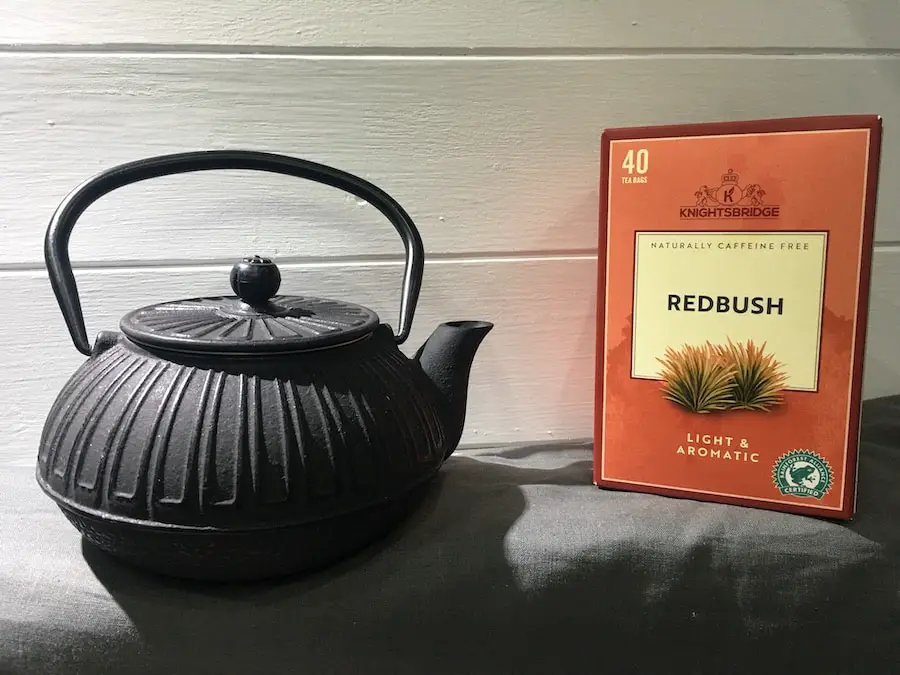
Health Benefits of Rooibos Tea
Rooibos tea is generous with minerals such as calcium, potassium, copper, manganese, zinc, and more. These, along with other extremely versatile compounds have given this tea some amazing benefits.
- Calcium
- Potassium
- Copper
- Manganese
- Zinc
- Other Trace Elements
Rooibos Tea Is Rich in Antioxidants
Rooibos tea contains antioxidants like Aspalathin and Nothofagin. These elevate Rooibos tea a great beverage to boost the immune system. It also helps in preventing complications in diabetes and protects against many other diseases.
Rooibos tea also has antioxidants, just like the main teas have called – polyphenols, flavonols, flavonoids, and dihydrochalcones. These antioxidants enrich Rooibos with anti-inflammatory, antiviral, and antimutagenic qualities. Especially, flavonoids support in lowering risks connected to coronary heart diseases.
A study has also stated that drinking Rooibos tea regularly gives the liver the necessary potent antioxidants. This again helps to prevent cell metabolism that causes heart diseases and cancer.
Improves Heart Health
The anti-inflammatory nature of this tea helps in reducing blood pressure. In fact, a recent study has agreed with this benefit. The study says that Rooibos tea is a natural angiotensin-converting enzyme (ACE) inhibitor.
This means Rooibos tea can help in regulating blood pressure and assist in boosting the health of the heart.
Also, the antioxidant Quercetin helps in preventing a variety of heart-related risks and diseases. Rooibos tea can also increase the rate of good cholesterol called HDL.
Alongside this, the binding of bad cholesterol called LDL in the walls of arteries and blood vessels is also prevented.
Controls Diabetes
The aspalathin antioxidant present in Rooibos has anti-diabetic properties. It helps regulate blood sugar, improves glucose absorption, and reduces insulin resistance. This effectively helps in preventing type 2 diabetes. Also, blood sugar spikes and drops are effectively controlled promoting a healthy lifestyle.
Good for Bones and Teeth
The Calcium and Manganese present in Rooibos help to promote the development of a strong bone structure and stronger teeth. Fluoride present in Rooibos helps prevent dental cavities and decay. This is why almost all toothpaste and mouthwashes have fluoride in them.
Added to this, Rooibos provides deeper benefits in building bones and repairing bone damage. Some researchers also say Rooibos can reduce the chances of arthritis, osteoporosis, and chronic joint pain. This is possible by the minerals present in the tea – which in turn increases the mineral content in the system.
Potential Cure for Allergies
In its native land South Africa, Rooibos was used as a medicine. Allergies like hay fever and eczema were thought to find a cure in Rooibos. This is supported by the presence of the quercetin element in Rooibos. Asthma and certain other topical allergies are also often prescribed with Rooibos.
Delays Aging
Always a benefit for those looking to maintain youthful skin. Alpha-hydroxy acid and zinc in red-bush tea can be beneficial for good skin. It has the ability to partially restore aged cells while reducing several other premature aging symptoms.
Likewise, the degeneration of fat cells which causes aging is slowed. In this way, the formation of wrinkles is delayed, therefore causing a delay in aging. Some antioxidants in the tea are also thought to help to get rid of elements that damage the skin bones and hair altogether.
Eases Colic, Stomach Pains, and Cramps
Rooibos is also used as a treatment for stomach pain or colic, especially in South Africa. Many say anti-inflammatory properties in the tea are responsible for this added benefit.
The antispasmodic properties, ease abdominal pains and stomach cramps.
Also, diarrhea and other intestinal issues can help be prevented by Rooibos. This is possible by using the potassium in the tea to reduce the hyperactiveness located in the gastrointestinal tract.
Provides Stress Relief
This benefit is something the busy world we’re in definitely needs. Stress, tension, and other distressing occasions create hypertension, increasing blood pressure. Rooibos tea helps reduce high blood pressure by increasing airflow to the lungs. For this purpose, Rooibos acts as a bronchodilator.
Lowering blood pressure can also help prevent atherosclerosis, heart attacks, and other cardiovascular diseases.
Absolutely Caffeine-Free
This is a benefit that comes from the specialty of Rooibos tea. As it’s a Herbal Tea, Rooibos tea is absolutely caffeine free and so it’s suitable for all age groups and even patients of insomnia. Removing or avoiding caffeine in tea, or even your diet has many benefits for a healthy lifestyle. Starting from lowering stress levels, to improving overall mood, Rooibos tea can give a much healthier lifestyle.
Although I should point out that in fact, many teas contain trace elements of Caffeine, but they’re barely noticeable on any scale. I’m just mentioning it to be totally accurate for you.
In fact, research has shown having a cup of Rooibos tea before bed also promotes a better night’s sleep. As such, Rooibos tea serves as the best alternative in getting away from addictive and harmful components in other types of teas.
Best Tea Substitute for People With Kidney Stones
The oxalic acid in other types of teas prevents people with kidney stones from consuming tea. In fact, oxalic acid worsens the calcium or other kidney stones even further by enlarging them. Surprisingly Rooibos tea does not cause these kidney stones. So people with kidney stones can use Rooibos tea as a perfect substitute.
An Excellent Choice for a Refreshing Beverage
On a more preference-related footing, for many people, Rooibos tea is indeed an excellent choice for a beverage. Especially beneficial and popular among athletes, children, and travelers who can use this as a great thirst quencher. This (mostly) caffeine-free tea in its natural form without any sweeteners is a refreshing drink.
All these benefits give you plenty of reasons to include Rooibos tea in your daily diet. However, let me also point out that not all these benefits are clinically proven or studied. So to keep it on a balanced and cautious level, we’ll discuss a few possible side effects of this herbal beauty.
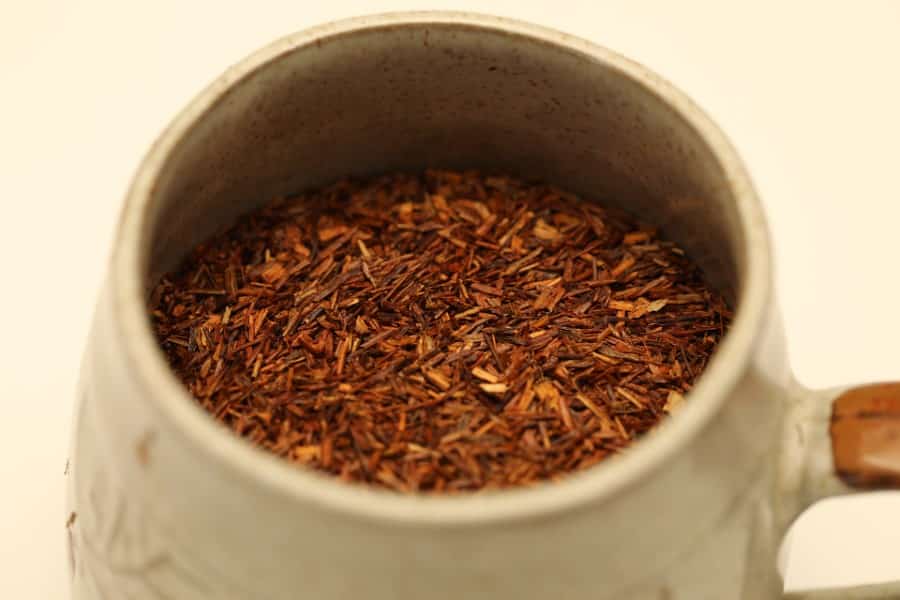
Rooibos Tea Side Effects
Before I start off, if you have any medical concerns triggered by tea or any other beverages, be sure to consult a doctor before use. So that said, here are a few of the possible side effects of Rooibos tea…
Risk of Hepatotoxicity
This is a condition whereby the liver becomes damaged due to certain harmful chemical compositions. In a study in 2010, it was clinically proven that Rooibos tea develops hepatotoxicity. This is because Rooibos tea has certain properties that increase liver enzymes. This causes the internal structure of the liver organ to gradually become damaged.
Estrogenic Activity
Some estrogenic activities are also reflected in Rooibos tea. This is where the production of estrogen or female hormones increases. The overproduction of estrogen can promote harmful side effects or even worsen diseases like breast cancer. This is because breast cancer is sensitive to estrogen and overproduction of it can increase the growth rate of cancer cells.
Excessive Antioxidant May Not Always Be Beneficial
Even though I’m always emphasizing the benefits of rich antioxidants in most teas, as well as Rooibos tea, it can also be a threat. This side effect is mainly a result of antioxidants combined with other chemical components in the system. Potentially, when antioxidants combine with chemotherapeutic drugs it can cause severe health problems. This is often caused by improper (mostly excessive) dosage.
Can Be Toxic When Consumed Fresh
Rooibos tea that is fresh can be toxic. This is because fresh Rooibos can be contaminated with salmonella or other bacteria – causing toxic reactions.
Irons Are Hard to Be Absorbed
Like most tea, Rooibos is low in tannin. This makes it difficult to absorb the iron properties of vegetables. So it’s generally recommended for everyone and especially for iron deficient patients to drink Rooibos tea only after meals. Also, follow the rule for drinking tea at night.
Breathing and Skin Problems
People who have allergies can easily get breathing troubles and sometimes little skin problems. Rashes, swollen skin, skin itchiness, tightening of the chest, and so on are common symptoms of this side effect.
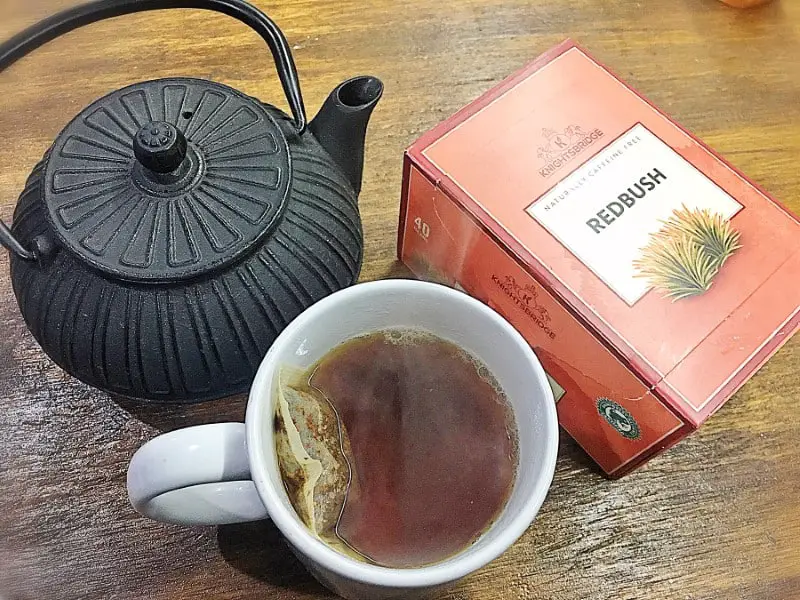
Possible Side Effects for Mothers and Babies
This might be highly concerning for pregnant or breastfeeding moms. The side effects come from the combination of different supplements the mom is taking along with the tea. The side effects can sometimes be transferred to the baby as well.
So as you can understand, as much as Rooibos tea has many benefits to boast about, it equally has side effects. So it is always recommended that you consult your doctor before including this in your daily diet.
For me, I would normally see side effects as part of life, everything we consume these days seems to have some negative value to it – if not known already someone always seems to discover ‘bad things’ about them. So I always err on the side of the balance and all things in moderation. So I’m flying the flag a little for Rooibos. Don’t be scared of having the occasional cup of Rooibos tea.
So now, hopefully, you know just about all the essential information regarding Rooibos, so let’s look at how best to make a cup of Rooibos tea.
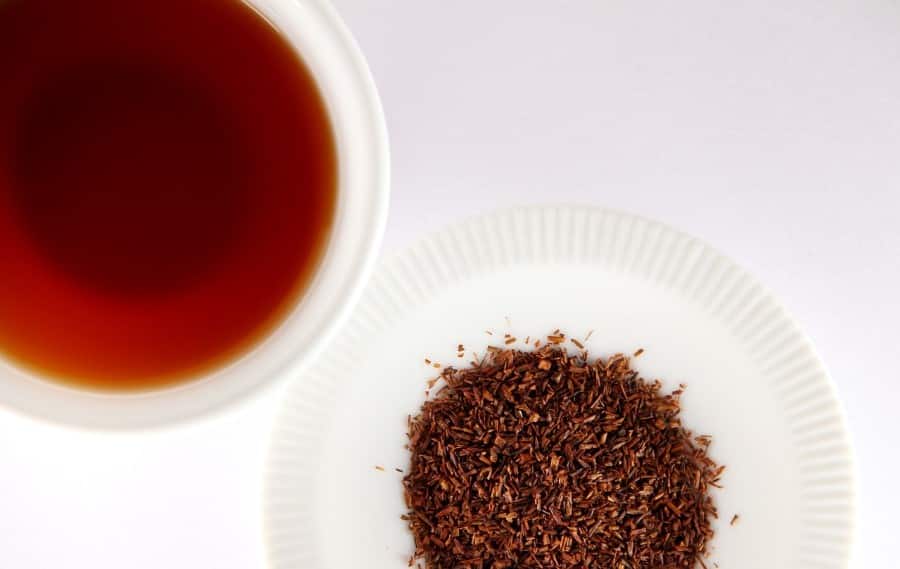
How to Make a Cup of Rooibos Tea
There are, thankfully, plenty of ways to make a nice cup of Rooibos tea. But to keep it simple for any new users among us, I’ll discuss the more traditional way of preparing Rooibos tea.
Things You’ll Need
- 1 ½ teaspoon of Rooibos tea leaves
- 8 ounces of boiling water (236.58 ml)
- Teapot
- A cup to stir
- Strainer
- A cup to serve
Steps to Making Rooibos Tea
- Pour 8 ounces of water into a teapot and allow it to reach a rolling boil.
- Remove the water pot from the stove and pour the water into a cup and add 1 ½ teaspoons of Rooibos tea leaves
- Allow the tea leaves to steep for 4-5 minutes
- Stir well and filter to the serving cup
- And your aromatic Rooibos tea is ready to drink
Some Free Hints and Tips
Rooibos tea tastes best with spring or filter water
You can add sweeteners, milk or cream after filtering the steeped tea. But make sure to mix well before serving. But naturally, Rooibos tea is sweet and is definitely delicious in its traditional method of brewing.
Allow the tea to steep for ten minutes to absorb all the minerals, nutrients, and antioxidants from the tea leaves. But you may get a very strong tea taste.
Avoid supermarket Rooibos, it tends to be of low quality. Try your local tea specialty stores, but if you can’t find it there, then you could always try these few flavors I’ve hand-picked for you on Amazon…
To get just the pure taste of Rooibos Tea then give this one a try –
Davidsons Organic South African Rooibos – 16oz Bag
If you want a bit of a sweet treat along with your Rooibos then try this – Caramel Flavored Loose Leaf Tea
Or finally, for a more luxurious taste, I’d recommend you try this
Twinings Golden Rooibos and Caramel – 3.52oz Caddy
Hope you like them. Do let me know in the comments below what you thought.
If you’re interested in becoming a tea specialist and want to find out what it takes, then check out my article for more information, as well as where to find courses.
Or, if you just want to discover more about the benefits of Rooibos Tea, then check out Rooibos: An Amazing Discovery by Dr, Annique Theron.
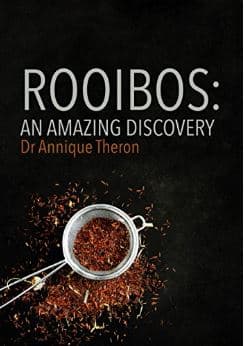
Conclusion
I’ve already mentioned above about the side effects not necessarily putting you off Rooibos tea, many millions of people drink it and are fine. If it were so bad it would be outlawed by now I’m sure. But of course, that said, check with your doctor if you have any concerns in this department.
But anyway for me, I like it, it’s a unique taste, slightly sweet but not overly so, aromatic and ‘herbally’. You almost feel like it’s doing some good for you when you drink it.
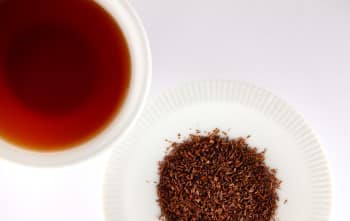
I foundthe tea in south africa 2 yrs ago thankfully its now in USA I enjoy it every m morning, but I put collegen into my morning cup is this OK?. makes me happy. Thank you Joanna
Good to read this, this article is very helpful.